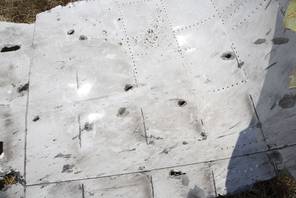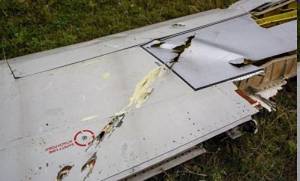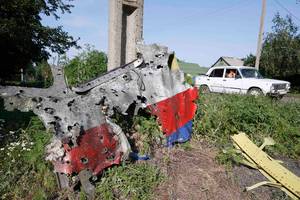Shocking Analysis of the ‘Shooting Down’ of Malaysian MH17

Peter Haisenko in Cockpit of Condor DC 10
By Peter Haisenko
Zur deutschen Version bitte hier anklicken
The tragedy of Malaysian MH 017 continues
to elude any light of clarity being cast over it. The flight recorders
are in England and are evaluated. What can come of it? Maybe more than
you would assume. Especially the voice recorder will be interesting when
you look at the picture of a cockpit fragment. As an expert in aviation
I closely looked at the images of the wreckage that are circulating on
the Internet.
First, I was amazed at how few photos can be found from the wreckage
with Google. All are in low resolution, except one: The fragment of the
cockpit below the window on the pilots side. This image, however, is
shocking. In Washington, you can now hear views expresssed of a
“potentially tragic error / accident” regarding MH 017. Given this
particular cockpit image it does not surprise me at all.
Entry and exit impact holes of projectiles in the cockpit area
I recommend to click on the little picture to the right. You can
download this photo as a PDF in good resolution. This is necessary,
because that will allow you understand what I am describing here. The
facts speak clear and loud and are beyond the realm of speculation:
The cockpit shows traces of shelling! You can see the entry and exit holes. The edge of a portion of the holes is bent inwards. These are the smaller holes, round and clean, showing the entry points most likeley that of a 30 millimeter caliber projectile. The edge of the other, the larger and slightly frayed exit holes showing shreds of metal pointing produced by the same caliber projectiles. Moreover, it is evident that at these exit holes of the outer layer of the double aluminum reinforced structure are shredded or bent – outwardly! Furthermore, minor cuts can be seen, all bent outward, which indicate that shrapnel had forcefull exited through the outer skin from the inside of the cockpit. The open rivets are are also bent outward.
In sifting through the available
images one thing stands out: All wreckage of the sections behind the
cockpit are largely intact, except for the fact that only fragments of
the aircraft remained . Only the cockpit part shows these peculiar marks
of destruction.
This leaves the examiner with an important clue. This
aircraft was not hit by a missile in the central portion. The
destruction is limited to the cockpit area. Now you have to factor in
that this part is constructed of specially reinforced material. This is
on account of the nose of any aircraft having to withstand the impact of
a large bird at high speeds.
You can see in the photo, that in this area significantly
stronger aluminum alloys were being installed than in the remainder of
the outer skin of the fuselage. One remembers the crash of Pan Am over
Lockerbie. It was a large segment of the cockpit that due to the special
architecture survived the crash in one piece. In the case of flight MH
017 it becomes abundantly clear that there also an explosion took place
inside the aircraft.
Tank destroying mix of amunititon

So what could have happened? Russia recently
published radar recordings, that confirm at least one Ukrainian SU 25 in
close proximity to MH 017. This corresponds with the statement of the
now missing Spanish controller ‘Carlos’ that has seen two Ukrainian
fighter aircraft in the immediate vicinity of MH 017. If we now consider
the armament of a typical SU 25 we learn this: It is equipped with a
double-barreled 30-mm gun, type GSh-302 / AO-17A, equipped with: a 250
round magazine of anti-tank incendiary shells and splinter-explosive
shells (dum-dum), arranged in alternating order. The cockpit of the MH
017 has evidently been fired at from both sides: the entry and exit
holes are found on the same fragment of it’s cockpit segment! Now just
consider what happens when a series of anti-tank incendiary shells and
splinter-explosive shells hit the cockpit. These are after all designed
to destroy a modern tank. The anti-tank incendiary shells partially
traversed the cockpit and exited on the other side in a slightly
deformed shape. (Aviation forensic experts could possibly find them on
the ground presumably controlled by the Kiev Ukrainian military; the
translator).
After all, their impact is designed to penetrate the solid armor of a tank. Also, the splinter-explosive shells will, due to their numerous impacts too cause massive explosions inside the cockpit, since they are designed to do this. Given the rapid firing sequence of the GSh-302 cannon, it will cause a rapid succession of explosions within the cockpit area in a very short time. Remeber each of these is sufficient to destroy a tank.
What “mistake” was actually being committed – and by whom?

The MH 017 looked similar in it’s tricolor design to that that of the Russian President’s plane. The plane with Presdient Putin on board was at the same time ”near” Malaysia MH 017. In aviation circles “close” would be considered to be anywhere between 150 to 200 miles. Also, in this context we might consider the deposition of Ms. Tymoshenko, who wanted to shoot Presdient Putin with a Kalashnikov.Source
But that this remains pure speculation. The shelling of the cockpit of air Malaysia MH 017, however, is definitely not.

No comments:
Post a Comment